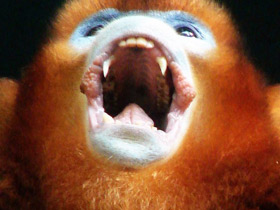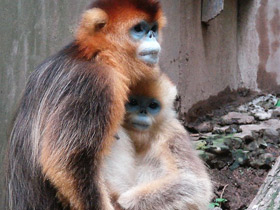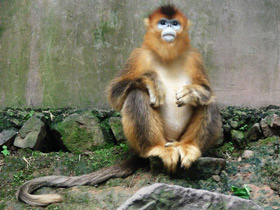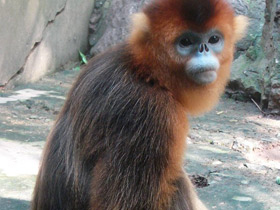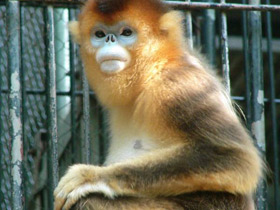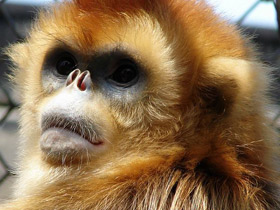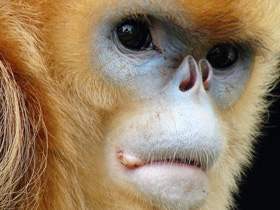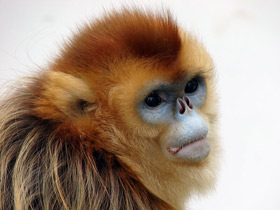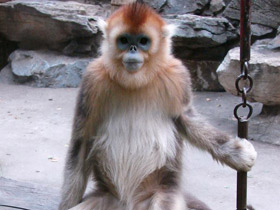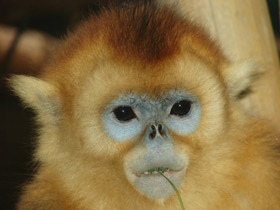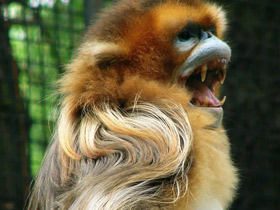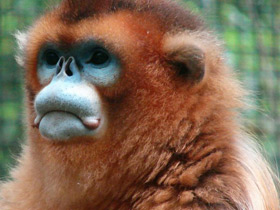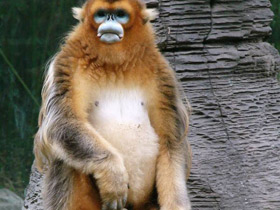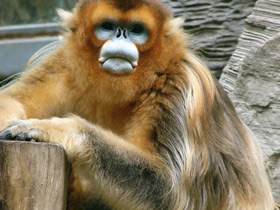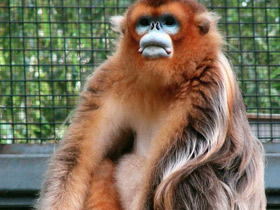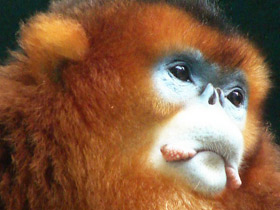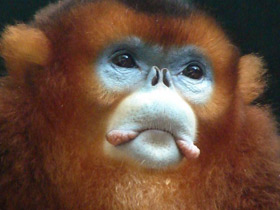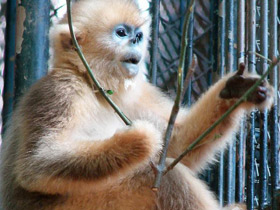The golden snub-nosed monkey (Rhinopithecus roxellana)
The golden snub-nosed monkey (Rhinopithecus roxellana) is an Old World monkey in the subfamily Colobinae. It is endemic to a small area in temperate, mountainous forests of central and Southwest China. They inhabit these mountainous forests of Southwestern China at elevations of 1,500–3,400 m (4,900–11,200 ft) above sea level. The Chinese name is Sichuan golden hair monkey (四川金丝猴). It is also widely referred to as the Sichuan snub-nosed monkey. Of the three species of snub-nosed monkeys in China, the golden snub-nosed monkey is the most widely distributed throughout China.
Snow occurs frequently within its range, and it can withstand colder average temperatures better than any other non-human primate. Its diet varies markedly with the seasons, but it is primarily a herbivore with lichens being its main food source. It is diurnal and largely arboreal, spending some 97% of its time in the canopy. There are three subspecies. Population estimates range from 8,000 to 15,000 and it is threatened by habitat loss.
Taxonomy
Biologists presently identify three subspecies of this monkey, which can be distinguished primarily by the length of their tails, as well as by certain skeletal and dental features. The dense human settlement of much of eastern Sichuan and the Han River valley of southern Shaanxi creates geographical separation between the three subspecies.
- Moupin golden snub-nosed monkey, Rhinopithecus roxellana roxellana. This subspecies is found in the mountainous areas flanking the Sichuan Basin from the west and north. According to the estimates made between 1995 and 2006, the population includes some 10,000 individuals, living mostly in Sichuan. Of them, some 6,000 lived in the Min Mountains of northern Sichuan, 3,500 in the Qionglai Mountains further west, and 500 in the Daxiangling and Xiaoxiangling ranges of south-central Sichuan. Smaller groups are also found just north of Sichuan border, in the border counties of Gansu (Wen County; about 800 individuals in eight troops) and Shaanxi (Ningqiang County, about 170-200 individuals in one or two troops).
- Qinling golden snub-nosed monkey, Rhinopithecus roxellana qinlingensis. According to an estimate published in 2001, this subspecies included some 3,800-4,000 individuals (about half of them adults) in 39 in Qinling Mountains of southern Shaanxi. The Qinling Mountains are separated from the more southern Min–Daba Mountains belt by the wide and comparatively densely populated Han River valley.
- Hubei golden snub-nosed monkey, Rhinopithecus roxellana hubeiensis. Members of this subspecies reside in the Daba Mountains (in particular, their Shennongjia section) of the westernmost Hubei (Shennongjia Forest District, Fang, Xingshan and Badong counties) and the northeastern Chongqing Municipality. According to a 1998 estimate, the population included 600–1,000 individuals in five to six troops. In 2005, the management of the Shennongjia Nature Reserve reported that the population had grown between 1990 and 2005 from 500 to over 1200.
Description
Rhinopithecus roxellana is a species of catarrhine primate of the family Cercopithecidae. The first European to see these fantastic apes was the French priest Armand David. He came to China in the 1860s as a missionary, but was far more successful in zoology than in converting the Celts to Catholicism. His name is commemorated in the name of the deer he found in the imperial park. David made two further discoveries in the pristine mountain forests of Sichuan province, where he discovered the great panda and the golden-faced blue-footed monkeys.
The famous zoologist Milne-Edwards, who studied the material David had brought back to Europe, was very surprised by their upturned noses, so much so that they almost reached the foreheads of the older specimens. He gave the newly discovered creatures the Latin name Rhinopithecus roxellanae. The generic name Rhinopithecus, "rhinopithecus", means "snub-nosed monkey", and the generic name was formed from the legendary beauty Roxolana, a slave and favourite wife of Sultan Suleiman the Magnificent, who was remembered by the inhabitants of Istanbul for her snub nose.
Rhinopithecus roxellana is a large ape: body length can reach 57-75 cm, tail length 50-70 cm, males weigh up to 16 kg, and females are much larger: they can weigh up to 35 kg.
Distribution
Rhinopithecus roxellana is found in southern and central China. The largest populations of these primates live in the Wolong National Reserve (Sichuan). Their habitats are found at latitudes in the subtropics and tropics, but they live in the mountains at altitudes ranging from 1,500 to over 3,000 metres.
The lower part of this belt is occupied by bamboo thickets and evergreen trees. Temperatures drop below freezing in winter and snowfalls are common, sometimes lasting up to six months of the year.
But the primates are so comfortable in these unsuitable conditions and tolerate the cold so well that they are often called "snow monkeys". During the warm season, Rhinopithecus monkeys go further up into the mountains, into the coniferous forests, to the upper edge of the taiga, and no further up because there are no trees there. In winter, Rhinopithecus roxellana go down to the foothills and valleys not so much for warmth as for food: there is no suitable food left for the monkeys in the snowy taiga.
Nutrition and lifestyle
In summer, they feed mainly on young leaves, shoots, fruits, flowers, seeds and lichens. In winter, Rhinopithecus roxellana switch to a coarse diet, not typical of other primates: they are able to digest tree bark and pine needles, and lichens become their main food.
Their warm, thick fur and peculiar behaviour help them keep warm in harsh winters. For example, females and cubs of different ages in the same family group sleep close together to keep warm; at night they are joined by other adult females.
Males usually sleep separately and are constantly on guard to protect their group from danger. Rhinopithecus roxellana spends most of its life in the trees, only coming down to earth to deal with relatives or neighbours. At the slightest danger, the monkeys instantly "fly" to the treetops.
Social behaviour and reproduction
Rhinopithecus roxellana usually lives in groups of 5-10 individuals consisting of a breeding pair and their offspring, but sometimes these family groups gather in huge flocks of up to 600 individuals. Males may live alone or join groups of males, so females in family groups try to forge social bonds with non-male females.
Male Rhinopithecus roxellana reach sexual maturity at 7 years and females at 4-5 years. Pregnancy lasts 7 months and offspring are cared for by both parents. Females usually have helpers and the cubs are protected by all members of the group. When in danger, they are placed in the centre of the group, while the males move towards the enemy.
Threats to existence
Rhinopithecus roxellana is a snow- and frost-tolerant monkey, able to feed anywhere, and flourished at a time when the mountains of southern and central China were covered with endless forests. However, hard-working Chinese peasants have been reclaiming more and more of the forest land century after century, and have also hunted these unique monkeys.
In recent decades, Chinese authorities have become more concerned.
Rhinopithecus roxellana has been placed under protection, with a network of nature reserves and parks established in their habitats. Tough measures against poachers have helped to suppress illegal hunting and avert the threat of extinction of these amazing animals. Some 5 000 Rhinopithecus roxellana live in the local forests and are listed as endangered by the International Union for Conservation of Nature.
The monkeys do not form a single population, but live in separate families on forest islets separated by an impassable sea. Meanwhile, a normal family of monkeys needs between 15 and 50 km2 of forest to live. Therefore, only a few, if any, families live on each island. Genetic exchange between such isolated groups is almost impossible and this condemns them to extinction within a few generations.
Experts have not yet found a solution to the problem. The idea of moving young animals from one reserve to another or releasing captive-born apes into the wild has been discussed. But for these programmes it is necessary to know much more about Rhinopithecus roxellana than is currently known. Information is needed not only on the composition of its diet and the timing of its reproduction, but also on the relationships between members of the group and between the group and outsiders.

















